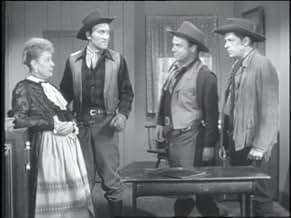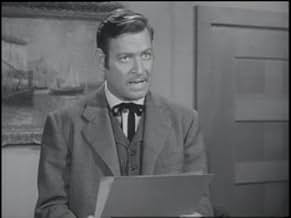Ajouter une intrigue dans votre langueThe adventures of the masked Texas Ranger and his Native American partner.The adventures of the masked Texas Ranger and his Native American partner.The adventures of the masked Texas Ranger and his Native American partner.
- Nommé pour 2 Primetime Emmys
- 3 nominations au total
Avis à la une
As an adult and watching the earliest episodes, it occurred to me that Tonto, actually gave all the idea's for his partners image. It was Tonto that suggested the mask. It was Tonto that suggested the silver bullets, and it was Tonto that came up with the name for Silver..when he proclaimed that the horse the Lone Ranger saved from death was "Silver White"! At last, as Tonto stood with the lone surviving Ranger over the graves of the others, Tonto, proclaimed "You are all alone now..You Lone Ranger! Of course, the response was "Yes Tonto, I am..The Lone Ranger!
The bonds of friendship and trust for the Lone Ranger and Tonto, was used 25 years later as an example of true friendship in an episode of Happy Days. In this particular episode, where Ritchie wanted to expose Fonzie for hating liver. The remark from Fonzie that typified what a true friendship should be was this "Many people tried to remove the mask of the Lone Ranger, but Tonto "never tried". All of America knew and felt that the truest of friendships would be to be like The Lone Ranger and Tonto.
Clayton Moore and Jay Silverheels are beloved for more than just being actors in a great western that will live forever. They are symbolic of so much more and as I said..will always be my hero's.
Most of the credit for the show's success goes to its leads, Clayton Moore and Jay Silverheels. They became the Lone Ranger and Tonto, lived the roles as no other actors before or since. Moore, in particular, knew the Ranger was presented as a hero and an example to children, and from what I've heard, he tried his best to live up to that. He made the Ranger a fair and just man, someone who didn't judge, who gave people the benefit of the doubt, but acted correctly when the time was right. He used violence only as a last resort. He was a symbol of honor and integrity, the kind of person I wish I could be.
As for Tonto... It occurs to me nowadays how great an actor Jay Silverheels was. Critics of the show always want to use Tonto as the stereotypical ignorant savage, but you have to look at all the things Tonto does. Tonto tracks, takes care of the Ranger when he's wounded, spies out information - you can tell from the expressions on Silverheels' face that there's a lot more going on inside Tonto's head than he lets on. Don't let the broken English fool you!
The thing that really impresses me about `The Lone Ranger' now is how much of a partnership these two characters have. Tonto is not the Ranger's subordinate - they are friends, equals in their adventures. That, as much as any lesson taught in any episode, is what draws me back to the series after so many years: a tried and true friendship.
Oh, if only the Lone Ranger could ride again.
The new DVD set from Pop Flix contains the first 16 episodes (15 Sept-29 Dec 1949) and for some reason unknown to me episode 22 from the fifth season, for a total of 17 episodes (the same 17 available on last year's Mill Creek Entertainment release so these are probably in the public domain). These sets pretty much render "The Legend of the Lone Ranger" movie superfluous as all three episodes that were combined in 1952 to form the movie are included in these releases.
The early episodes hark back to radio as there is considerably more voice-over narration used as an introduction and to introduce key plot moments.
The series itself was pure kiddie western with clear-cut good and evil distinctions and no romance. The title character (played by Clayton Moore) started out Texas Ranger John Reid. The first three episodes provide the background for his transformation to Lone Ranger status, his partnering with the Indian Tonto (Jay Silverheels), and the taming of his horse "Silver".
There is an unambiguous code of positive morality infusing each episode. The Lone Ranger is totally good but he adopts the guise of evil. While a masked man in the west was normally feared by the good citizens and an Indian was distrusted, the Lone Ranger is feared by those who would do evil. One persistent theme is that when the Lone Ranger and Tonto first encounter an average citizen they are greeted with suspicion, and by the end of the episode the citizen has been convinced of their value. The trademark ending was a secondary character asking the question: "who was that masked man?".
To really enjoy the series you must accept it for the simplistic morality tale it was intended to be. If you don't take it seriously and keep wishing for some self-reflexive campy parody elements you will only get frustrated.
Then again, what do I know? I'm only a child.
Along with William Boyd's Hopalong Cassidy TV series, which was first telecast on NBC on June 24, 1949, it was among the earliest TV western series. Hopalong Cassidy actually debuted in 1948, when Boyd syndicated his films to NBC. (In 1947, Boyd had bought to the rights to his Hoppy films.)
Fran Stiker and George W. Trendle created the Lone Ranger as a local radio program in 1933. It quickly went nationwide and was the cornerstone of the old Mutual Radio network. Ironically, Hopalong Cassidy was also a Mutual radio program.
When The Lone Ranger was brought to TV in 1949, many of the radio plays were adapted to the younger medium. As a consequence, many of the earliest episodes show their radio origins with the use of a narrator who links the different scenes together. The Lone Ranger was the biggest hit on the new ABC network in its early years.
The first three episodes told the the familiar story of how the Lone Ranger came to be, his connection to Tonto, and the origins of his prize horse Silver. Glenn Strange played the villain Butch Cavandish in these episodes.
The Lone Ranger was also one of the earliest shows to film mostly outdoors. Starting in 1956, the Wrather Company began filming the program in color.
The Cisco Kid, starring Duncan Renaldo and Leo Carrillo had been filmed in color since its first aired in 1950. Jack Wrather, however, was more concerned about the competition to his kid's show from the new adult westerns that had began to appear on TV.
When the Lone Ranger appeared, The New York Times critic Jack Gould ripped the show, as "just another Western, and not a notably good one at that." Gould considered the first three episodes manipulative, mostly because of the cliffhanger endings of the first two episodes. The New York Times writer accused everyone associated with the program of keeping children "emotionally hopped upped." As a result of his criticisms, the cliffhanger type endings were never used after the first two episodes. Gould, however, had been suffering from a misunderstanding. The show had never intended to be broadcast as a serial despite the serial background of its star Clayton Moore.
In 1952, B-film actor John Hart replaced Clayton Moore. Moore had threatened to quit after 1950. He was being paid only $500 an episode for his hit show, and wanted a substantial raise. Audiences rejected Hart in the role, and after 36 episodes Moore was back atop Silver.
The Lone Ranger was the first Western Hit on TV.
The series was filmed in both Utah and in California.
Le saviez-vous
- AnecdotesThe Lone Ranger's young nephew, Dan Reid, who appeared occasionally on this show, was the father of Britt Reid, The Green Hornet. Both characters were created for radio by George W. Trendle.
- GaffesWhenever the Lone Ranger is seen putting on his mask, he secures it by tying it around the back of his head. During times when he loses his hat, say in a fight, it can be seen that the mask is secured with an elastic band.
- Citations
[first lines for each episode]
Narrator: The Lone Ranger!
[gunshots are fired]
The Lone Ranger: Hi-yo, Silver!
Narrator: A fiery horse with the speed of light, a cloud of dust and a hearty "Hi-yo Silver" - the Lone Ranger!
The Lone Ranger: Hi-yo, Silver, away!
Narrator: With his faithful Indian companion, Tonto, the daring and resourceful masked rider of the plains led the fight for law and order in the early West. Return with us now to those thrilling days of yesteryear. The Lone Ranger rides again!
- Versions alternativesThe first three episodes are available edited together as a ersatz feature "Enter the Lone Ranger" (1949) running 68 minutes minus titles and recaps.
- ConnexionsEdited into The Legend of the Lone Ranger (1952)
- Bandes originalesWilliam Tell Overture: Finale
(uncredited)
Written by Gioachino Rossini
[Played at program opening and during closing credits]
Meilleurs choix
- How many seasons does The Lone Ranger have?Alimenté par Alexa
Détails
- Date de sortie
- Pays d’origine
- Langue
- Aussi connu sous le nom de
- El llanero solitario
- Lieux de tournage
- Sociétés de production
- Voir plus de crédits d'entreprise sur IMDbPro
- Durée
- 30min
- Rapport de forme
- 1.33 : 1






































